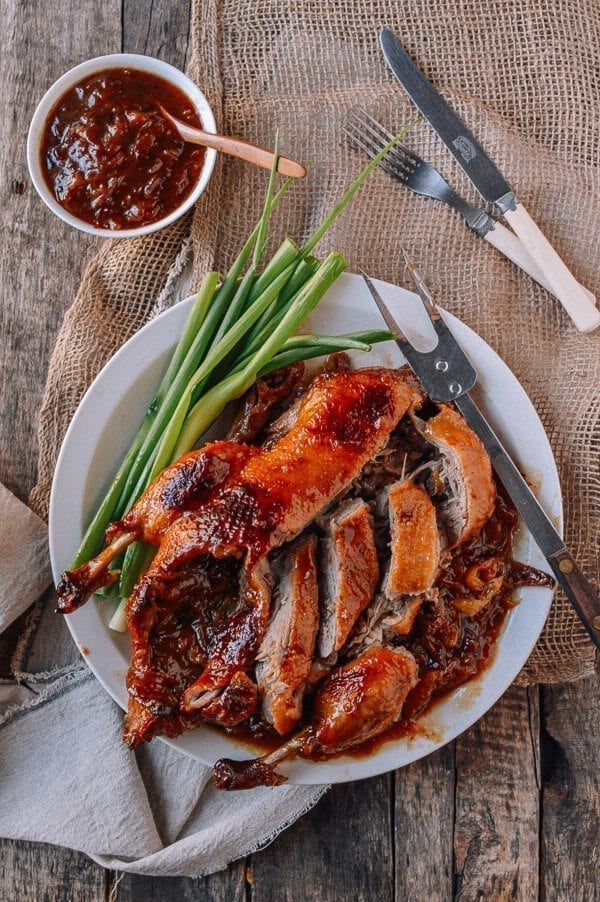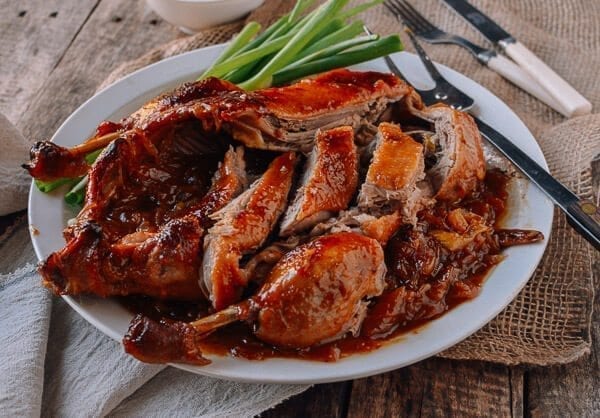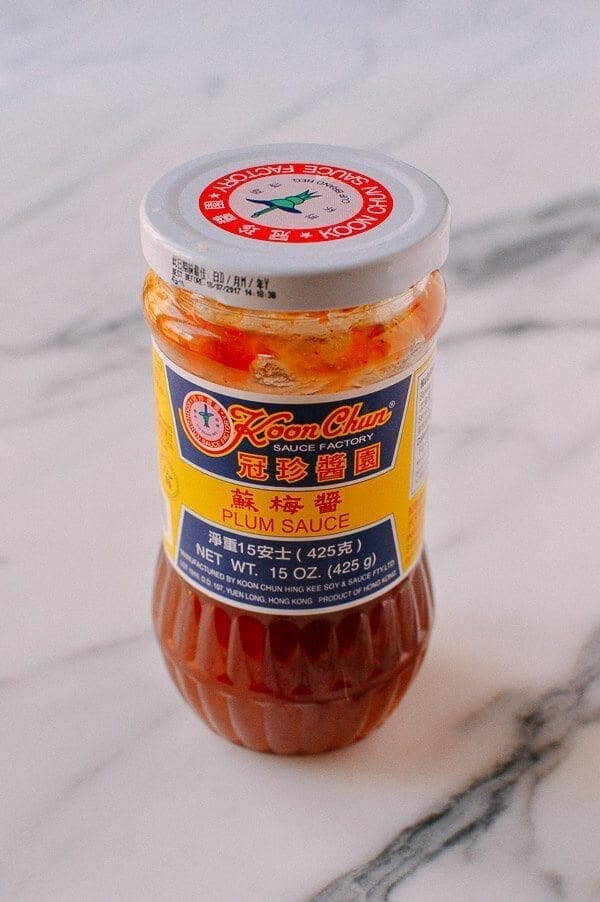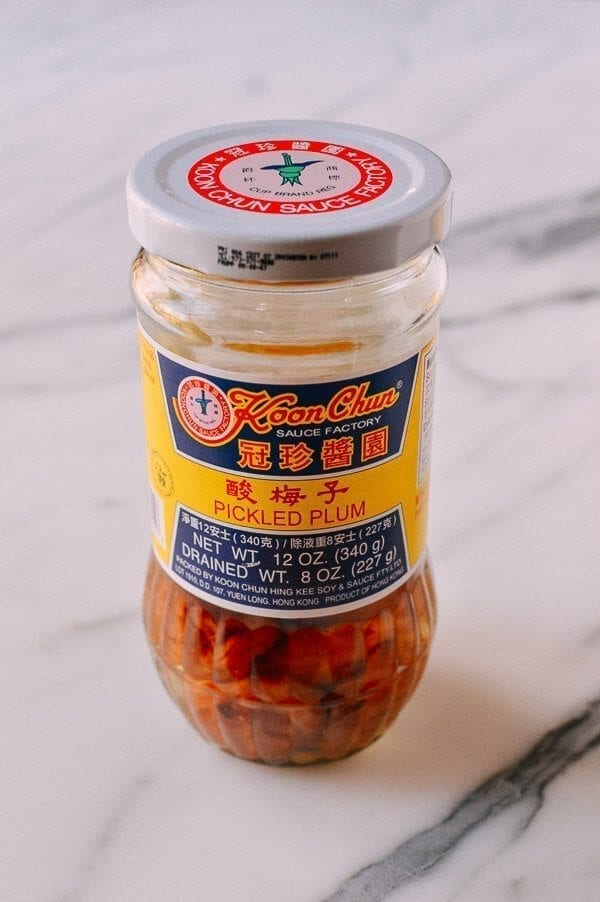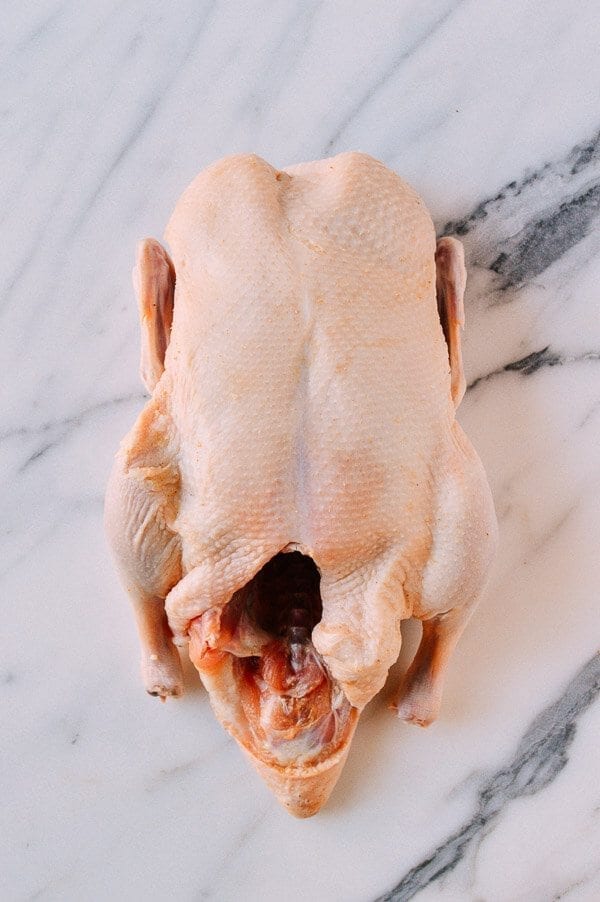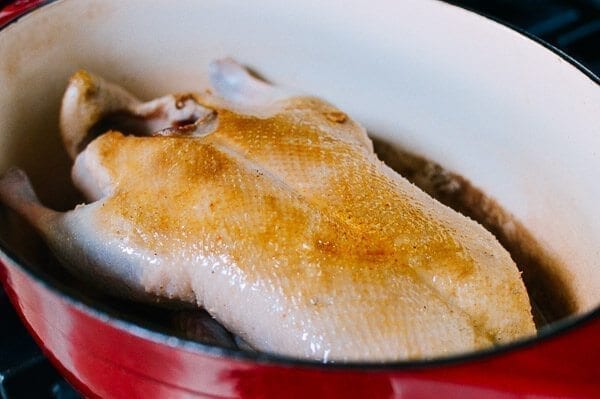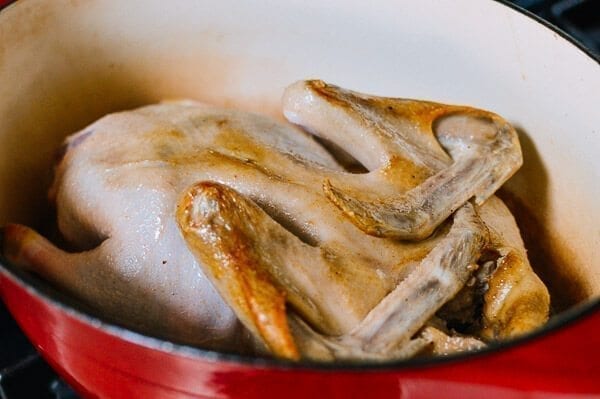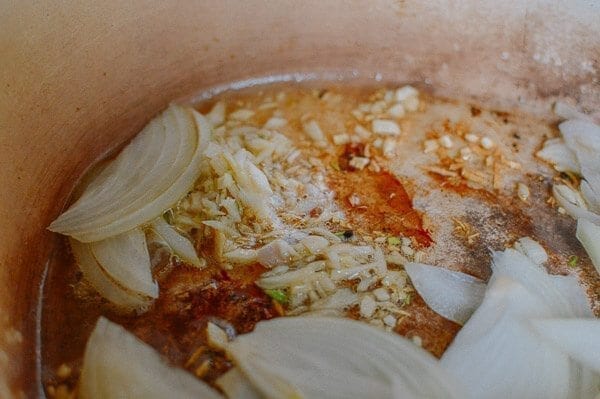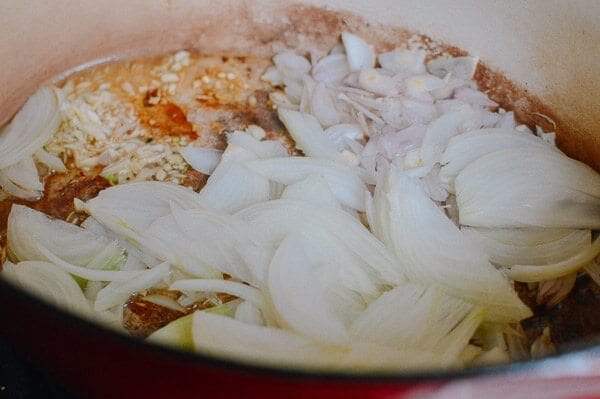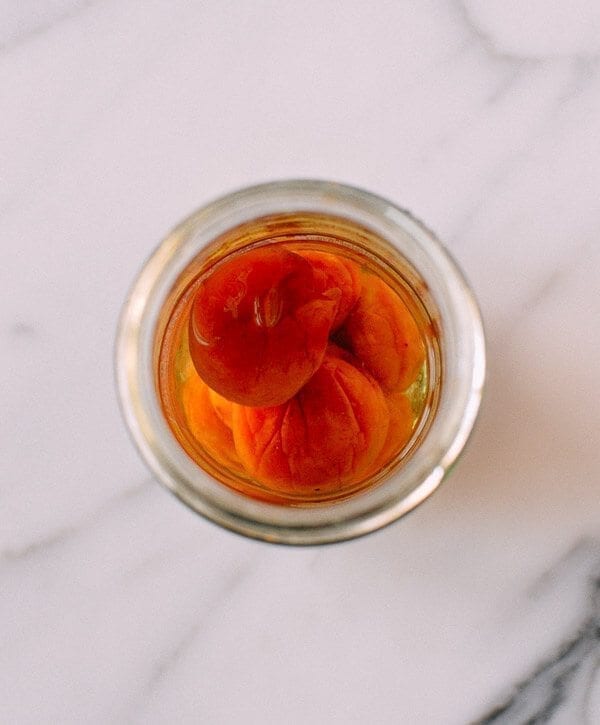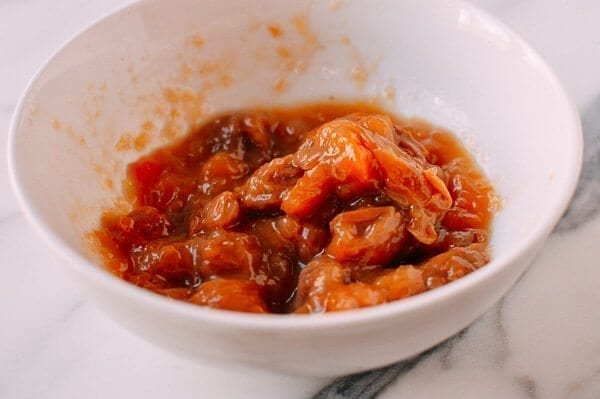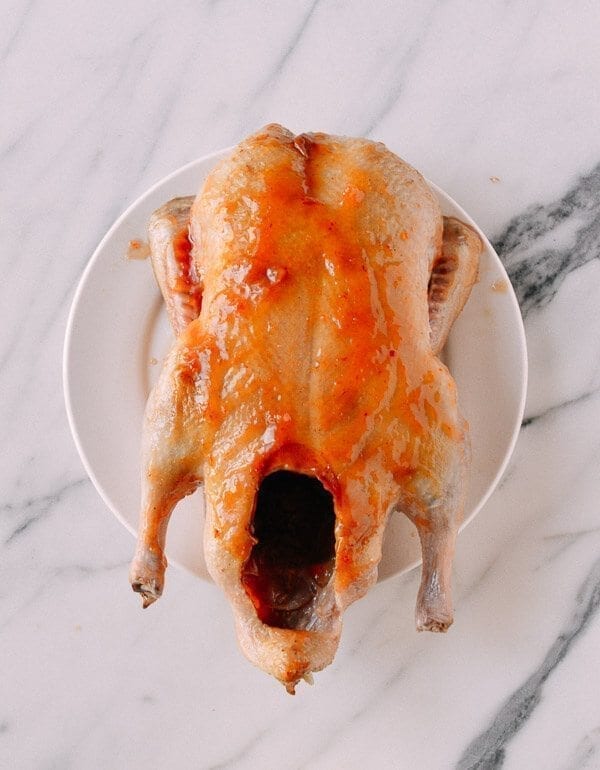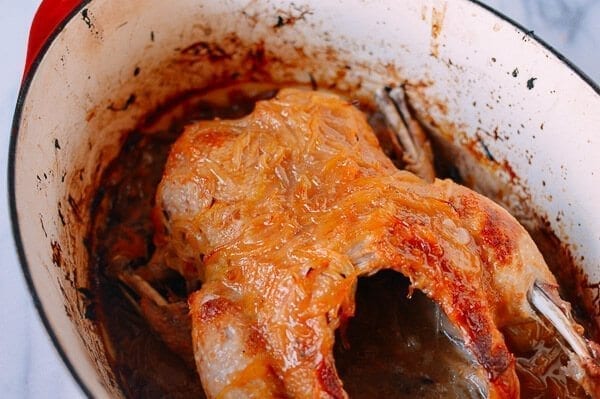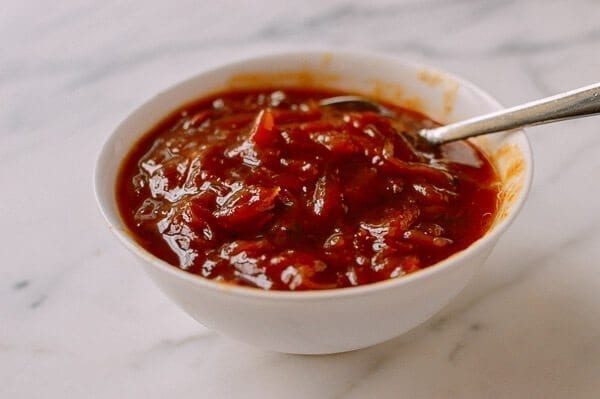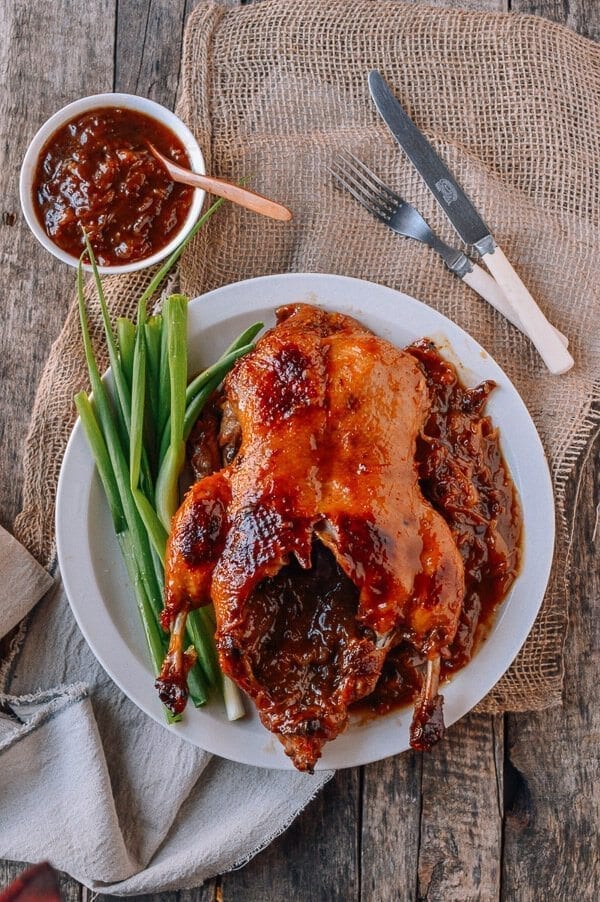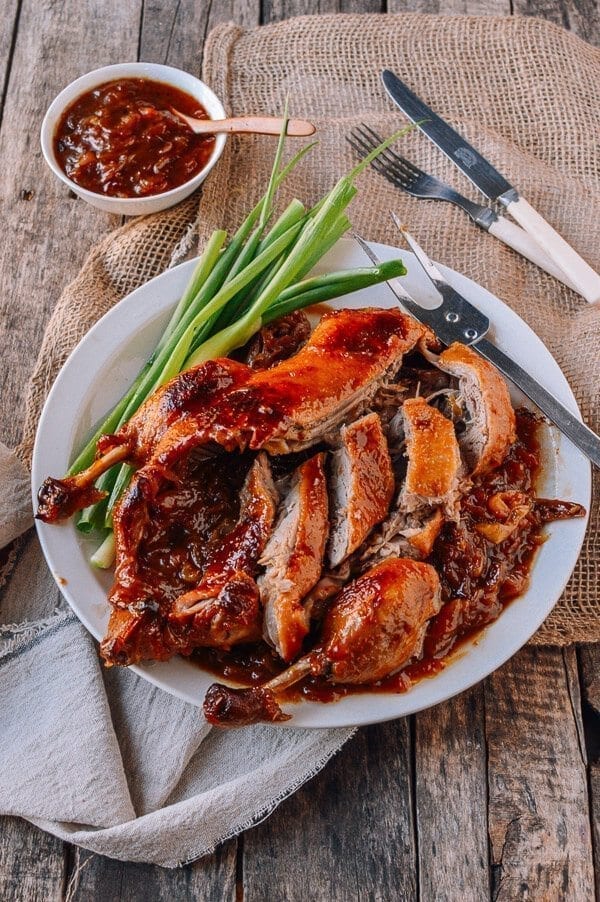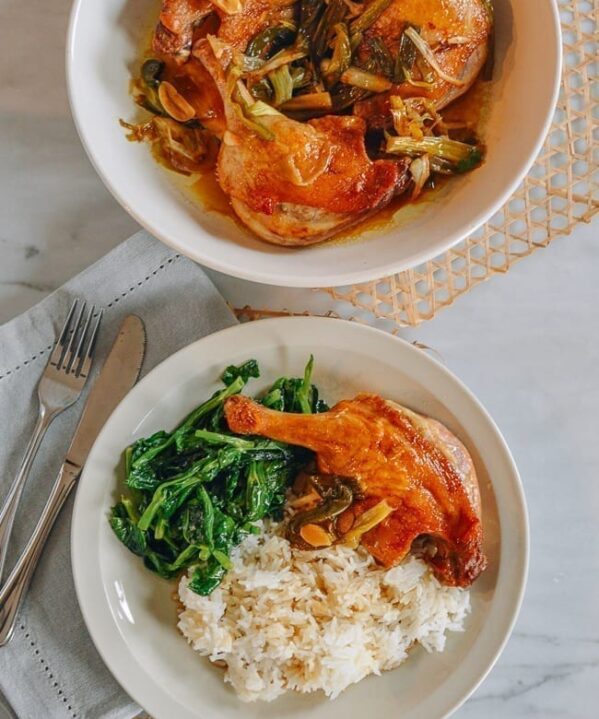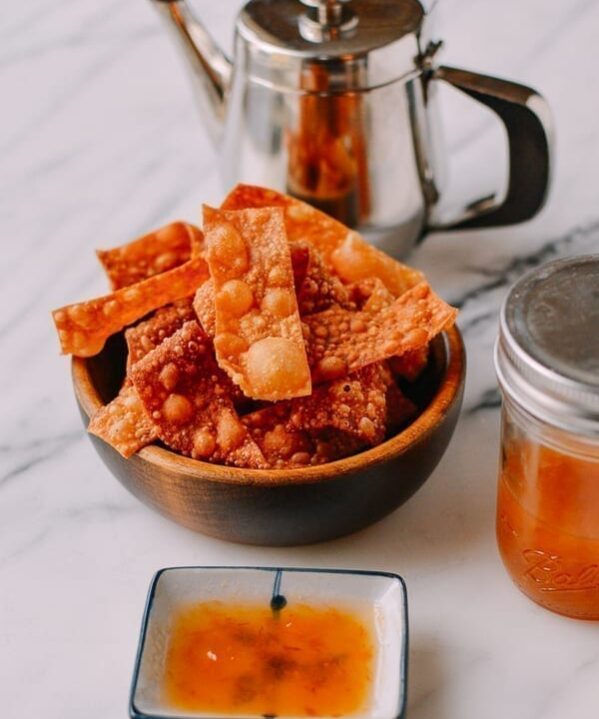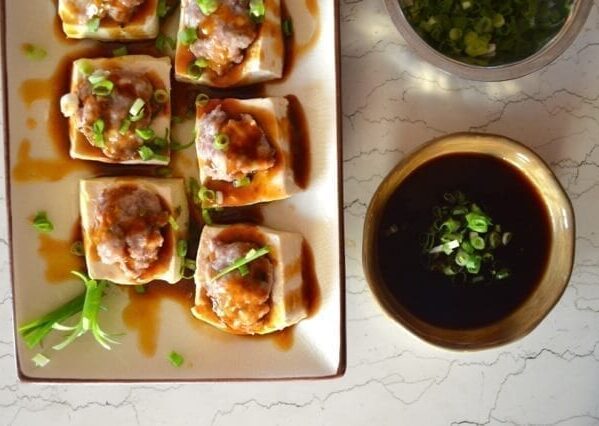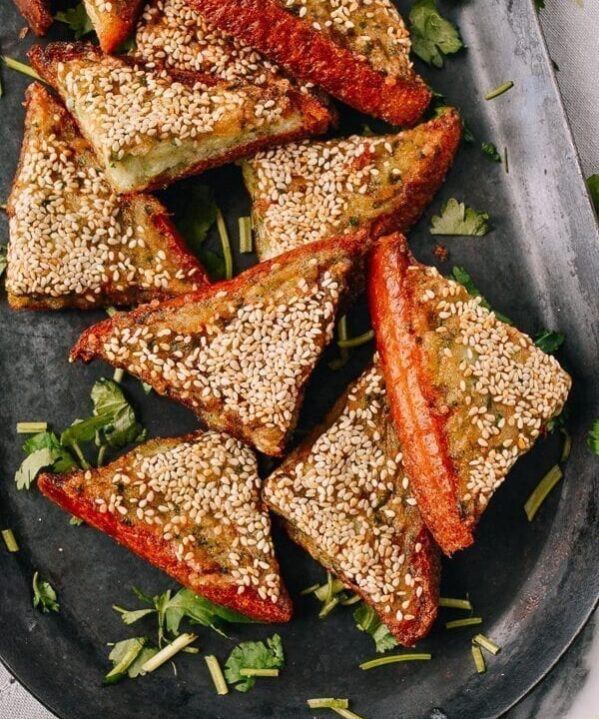We’re two weeks from Chinese New Year, and we have a bunch of new year’s recipes to share with you over the coming days! Some of them are more of our family favorites, and others are requests that we received from readers. We’re starting with a bang––one of my favorite dishes, Chinese Sour Plum Duck.
Sour plum duck was a special meal my father used to make for us as kids. He first made it one year on Chinese New Year’s day, and from then on, we’d beg him to make it even if it wasn’t a holiday!
I’m speculating now (a disclaimer for Judy and the girls, because they always say I speculate too much), but this dish might just be how the term Chinese “duck sauce” came into existence. I mean, the bright orange duck sauce you get in packets from Chinese takeout restaurants are obviously devoid of duck, and the sauce can be served with everything from fried rice to egg rolls. This sweet and sour condiment does bear a striking resemblance to plum sauce, however, which is the star flavor agent in this traditional duck recipe. See the connection?
I was probably around 5 years old when my father made our first Sour Plum Duck (pronounced in Cantonese with a Hakka accent, “suan moi opp”). Like a good son, I followed my father everywhere and watched his every move, wanting to be just like him. Thanks to that father-son bonding, I not only remember how delicious that sour plum duck was, but also enough of the steps to write this rarely-seen recipe.
Childhood memories are a weird phenomenon–what and how you remember certain things at a young age are so random. All I know is that I do vividly remember my father rubbing the fresh duck with salt and spices and then making the plum sauce by taking squishy brown things out if a jar and squishing them in his hands to crush them. The pits squeezed out of his fingers, and he just left them in the sauce. The rest of the ingredients in this recipe was developed by taste and educated guessing.
I’m also pretty sure he used the oven, and while I don’t clearly remember the onions, I wouldn’t be surprised if they were there in his original “suan moi opp” sour plum duck recipe. When the caramelized onions are cooked with the duck, you get an unbelievable onion marmalade that would put any jarred duck sauce to shame.
So, to all of you folks who have memories of your favorite dishes, dig deep in those treasured memories and think hard, because sometimes it’s really worth it. And if you’re lucky enough to have elders in your family with recipes and/or stories to share, don’t wait! Pick their brains now and write them down even if they are not perfect!
Here’s this treasured sour plum duck recipe–just in time for Chinese New Year. Hope you enjoy it!
Sour Plum Duck: Recipe Instructions
Remove the giblet packet from the duck, rinse both the inside and outside of the duck thoroughly, and let the water drain out. You can discard the giblets or place them in the pot with the duck if you like. Pat the duck dry with a paper towel.
Combine the salt, white pepper, and ginger in a small bowl, and rub the spice mix evenly all over the duck, both outside and inside the cavity. Set aside to marinate for 30 minutes.
Heat 1½ tablespoons canola oil in a large Dutch oven (or other oven-safe pot with a lid) over medium-high heat. Sear the duck on both sides until lightly browned and transfer the duck to a plate.
Preheat the oven to 375 degrees F. Add the garlic, shallots, and onions to the pot where you seared the duck. Fry for 3-5 minutes, until softened.
Use your hands or a fork to smash the pickled plums, and add them to the pot. The plums should be pitted, but it is also okay to just add the pits and pick them out before serving.
Also stir in the plum sauce, chicken stock, dried orange or tangerine peel, and rice vinegar. Mix well over medium heat and bring to a simmer. Once simmering, remove from the heat.
Spoon one cup of the onion mixture into the duck cavity, using a spoon to coat the inside of the duck as best as possible. Spread some of the sauce over the outside of the duck so it is lightly coated.
With the onion mixture that’s left in the pot, spread it out evenly across the bottom of the pot and carefully place the duck on top (breast side down). Cover the pot and place into the preheated oven for 60 minutes.
Take the pot out of the oven, and using a large roasting fork, carefully lift the duck up to dump the onions and liquid out of the cavity. Then carefully flip the duck so the breast is facing up. There should still be plenty of liquid at the bottom of the pan, but feel free to add a bit of chicken stock if it’s looking dry.
Cover and return to the oven for another 30 to 60 minutes depending upon how tender you like your duck. Check the duck after 30 minutes for tenderness and add more stock if the sauce is drying out. Once you are satisfied with the tenderness, cook for another 15 minutes uncovered. Again, if there is no sauce, add in more chicken stock. Transfer the pot from the oven to the stovetop, and carefully transfer the duck to a serving plate or cutting board for carving.
Stir the sauce, discarding the tangerine peels and plum pits. If all went well, the sauce should have turned into a beautiful onion marmalade. Reduce the sauce over the stovetop if it is too thin, or add chicken stock to deglaze if the sauce is too dry.
Spoon some of the sauce and onions over the top of the duck and serve the rest of the sauce on the side.
You’ll love this Chinese sour plum duck classic dish!
Sour Plum Duck, A Hakka Chinese Classic
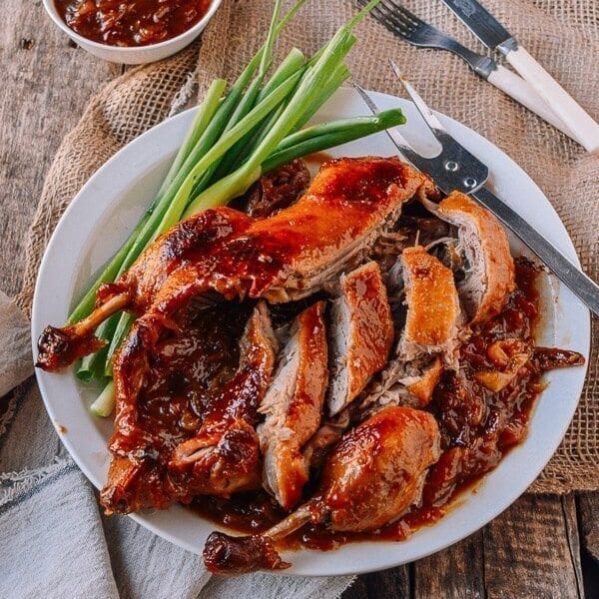
Ingredients
- 1 whole duck (2.25 kg, about 5 pounds)
- 1 teaspoon salt
- ½ teaspoon white pepper
- 1/4 teaspoon ground ginger
- 1½ tablespoons canola oil
- 2 cloves garlic (minced)
- 5 shallots (thinly sliced, about ½ cup)
- 3 large onions (thinly sliced, about 4 cups)
- 6 pickled plums (Koon Chun Brand)
- 1½ cups plum sauce (Koon Chun Brand)
- 1½ cups low sodium chicken stock (680g)
- 3 to 4 pieces dried orange or tangerine peel
- 1 tablespoon rice wine vinegar
Instructions
- Remove the giblet packet from the duck, rinse both the inside and outside of the duck thoroughly, and let the water drain out. You can discard the giblets or place them in the pot with the duck if you like. Pat the duck dry with a paper towel. Combine the salt, white pepper, and ginger in a small bowl, and rub the spice mix evenly all over the duck, both outside and inside the cavity. Set aside to marinate for 30 minutes.
- Heat 1½ tablespoons canola oil in a large Dutch oven (or other oven-safe pot with a lid) over medium-high heat. Sear the duck on both sides until lightly browned and transfer the duck to a plate. Preheat the oven to 375 degrees F. Add the garlic, shallots, and onions to the pot where you seared the duck. Fry for 3-5 minutes, until softened.
- Use your hands or a fork to smash the pickled plums, and add them to the pot. The plums should be pitted, but it is also okay to just add the pits and pick them out before serving. Also stir in the plum sauce, chicken stock, dried citrus peels, and vinegar. Mix well over medium heat and bring to a simmer. Once simmering, remove from the heat.
- Spoon one cup of the onion mixture into the duck cavity, using a spoon to coat the inside of the duck as best as possible. Spread some of the sauce over the outside of the duck so it is lightly coated. With the onion mixture that's left in the pot, spread it out evenly across the bottom of the pot and carefully place the duck on top (breast side down). Cover the pot and place into the preheated oven for 60 minutes.
- Take the pot out of the oven, and using a large roasting fork, carefully lift the duck up to dump the onions and liquid out of the cavity. Then carefully flip the duck so the breast is facing up. There should still be plenty of liquid at the bottom of the pan, but feel free to add a bit of chicken stock if it's looking dry.
- Cover and return to the oven for another 30 to 60 minutes depending upon how tender you like your duck. Check the duck after 30 minutes for tenderness and add more stock if the sauce is drying out. Once you are satisfied with the tenderness, cook for another 15 minutes uncovered. Again, if there is no sauce, add in more chicken stock. Transfer the pot from the oven to the stovetop, and carefully transfer the duck to a serving plate or cutting board for carving.
- Stir the sauce, discarding the tangerine peels and plum pits. If all went well, the sauce should have turned into a beautiful onion marmalade. Reduce the sauce over the stovetop if it is too thin, or add chicken stock to deglaze if the sauce is too dry.
- Spoon some of the sauce and onions over the top of the duck, and serve the rest of the sauce on the side.
